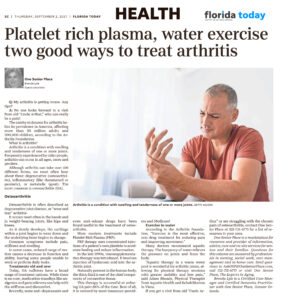
 Brenda Lyle – FLORIDA TODAY
Brenda Lyle – FLORIDA TODAY
Q: My arthritis is getting worse. Any tips?
 A: No one looks forward to a visit from old “Uncle Arthur,” who can really be a pain! The catchy nickname for arthritis belies its prevalence in America, affecting more than 50 million adults and 300,000 children, according to the Arthritis Foundation.
A: No one looks forward to a visit from old “Uncle Arthur,” who can really be a pain! The catchy nickname for arthritis belies its prevalence in America, affecting more than 50 million adults and 300,000 children, according to the Arthritis Foundation.
What is arthritis?
Arthritis is a condition with swelling and tenderness of one or more joints. Frequently experienced by older people, arthritis can occur in all ages, races and genders. Although arthritis can take over 100 different forms, we most often hear about three: degenerative (osteoarthritis), inflammatory (like rheumatoid or psoriatic), or metabolic (gout). The most common is osteoarthritis (OA).
Osteoarthritis (OA)
Osteoarthritis is often described as degenerative joint disease or “wear and tear” arthritis. It occurs most often in the hands and in weight bearing joints, like hips and knees. As it slowly develops, the cartilage within a joint begins to wear down and the underlying bone begins to change. Common symptoms include pain, stiffness, and swelling. In some cases, reduced range of motion causes a decrease in function and ability, leaving some people unable to work or perform daily tasks.
Treatments old and new
Today, OA sufferers have a broad range of treatment options. While there is no cure, medication standbys like analgesics and pain relievers can help with the stiffness and discomfort. Recently, some anti-depressants and even anti-seizure drugs have been found useful in the treatment of osteoarthritis.
More modern treatments include Platelet Rich Plasma (PRP). PRP therapy uses concentrated injections of a patient’s own platelets to accelerate healing and reduce inflammation. In the late ’90’s, viscosupplementation therapy was introduced. It involves injection of hyaluronic acid into the arthritic joint. Naturally present in the human body, the thick fluid is one of the chief components of connective tissue. This therapy is successful at reducing OA pain 86% of the time. Best of all, it is covered by most insurance providers and Medicare!
Exercise in water
According to the Arthritis Foundation, “Exercise is the most effective, non-drug treatment for reducing pain and improving movement.” Many doctors recommend aquatic therapy. The buoyancy of water relieves the pressure on joints and frees the body. Adam Rhoads, Physical Therapist from Aquatic Health and Rehabilitation in Viera, agrees. “Aquatic therapy in a warm water pool is wonderful for arthritic joints, allowing for physical therapy sessions with greater mobility and less pain.”
If you get a visit from old “Uncle Arthur” or are struggling with the chronic pain of osteoarthritis, contact One Senior Place at 321-751-6771 for a list of resources in your area.
One Senior Place is a marketplace for resources and provider of information, advice, care and on-site services for seniors and their families. Questions for this column are answered by professionals in nursing, social work, care management and in-home care. Send questions to AskOSP@OneSeniorPlace.com, call 321-751-6771 or visit One Senior Place, The Experts in Aging.
Brenda Lyle is a Certified Care Manager and Certified Dementia Practitioner with One Senior Place, Greater Orlando.


